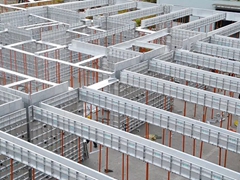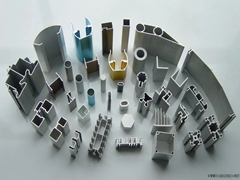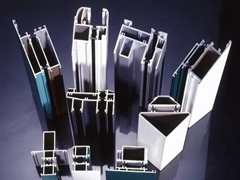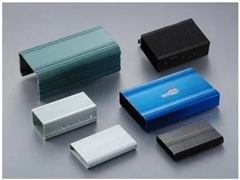Precautions for purchasing architectural aluminum profiles
Architectural aluminum profile is a metal raw material widely used in modern industrial industry and construction industry. High-quality aluminum profiles not only look gorgeous, but also have quite stable physical properties. However, since some unscrupulous merchants still use some inferior aluminum materials such as recycled aluminum as high-quality aluminum profiles, how to choose architectural aluminum profiles?
Precautions for the purchase of architectural aluminum profiles:
1. Check the ex-factory certificate of architectural aluminum profile products, pay attention to the production date, specifications, technical conditions, company name, and production license number.
2. Carefully check the surface condition of the aluminum profile products. The product should have bright color and good gloss, and there should be no obvious scratches, bubbles and other defects on the surface.
3. Be sure to pay attention to the wall thickness of aluminum profile products. The product thickness of door and window materials should not be less than 1.2 mm
4. Pay attention to the thickness of the surface coating of architectural aluminum profiles. The film thickness of anodized products is not less than 10μm, the film thickness of electrophoretic coating products is not less than 17μm, the film thickness of powder spray products is not more than 40-120μm, and the film thickness of fluorocarbon spray products should be more than two layers and not less than 30μm
5. For users in coastal areas, choose electrophoretic painted aluminum profiles, powder sprayed aluminum profiles or fluorocarbon sprayed profiles with good anti-corrosion properties.
The matters needing attention when purchasing aluminum profiles are:
1. Pay attention to product hardness: The hardness is first directly related to the chemical composition of the alloy. Second, different states also have a big impact. From the hardness that can be achieved, the 7 series, 2 series, 4 series, 5 series, 3 series, and 1 series decrease in turn.
2. Pay attention to product strength: Strength is an important factor that must be considered in product design, especially when aluminum alloy components are used as components, appropriate alloys should be selected according to the pressure. Pure aluminum has low strength, and 2-series and 7-series heat-treated alloys have high strength. Hardness and strength are positively correlated.
3. Pay attention to corrosion resistance: Corrosion resistance includes chemical corrosion resistance, electrochemical corrosion resistance and stress corrosion resistance. In general, 1 series pure aluminum has the best corrosion resistance, followed by 5 series, 6 series, 2 series, and 7 series. The selection principle of corrosion resistance should be determined according to its application. When high-strength alloys are used in corrosive environments, various anti-corrosion composite materials are required.
4. Pay attention to the machinability of aluminum profiles: machinability includes formability and machinability, etc. Because the formability is related to the state, after selecting the grade of aluminum alloy, the strength range of various states should be considered. Generally, materials with high strength are not easy to form. If aluminum is to be bent, drawn, and deep drawn, the formability of fully annealed material is the best, and the formability of heat treated material is the worst.
5. Pay attention to the welding performance of aluminum profiles: most aluminum alloys have no problems in welding, especially some 5 series aluminum alloys, which are specially designed for welding. Relatively speaking, some 2 series and 7 series aluminum alloys are more difficult to weld.
Precautions for the purchase of architectural aluminum profiles:
1. Check the ex-factory certificate of architectural aluminum profile products, pay attention to the production date, specifications, technical conditions, company name, and production license number.
2. Carefully check the surface condition of the aluminum profile products. The product should have bright color and good gloss, and there should be no obvious scratches, bubbles and other defects on the surface.
3. Be sure to pay attention to the wall thickness of aluminum profile products. The product thickness of door and window materials should not be less than 1.2 mm
4. Pay attention to the thickness of the surface coating of architectural aluminum profiles. The film thickness of anodized products is not less than 10μm, the film thickness of electrophoretic coating products is not less than 17μm, the film thickness of powder spray products is not more than 40-120μm, and the film thickness of fluorocarbon spray products should be more than two layers and not less than 30μm
5. For users in coastal areas, choose electrophoretic painted aluminum profiles, powder sprayed aluminum profiles or fluorocarbon sprayed profiles with good anti-corrosion properties.
The matters needing attention when purchasing aluminum profiles are:
1. Pay attention to product hardness: The hardness is first directly related to the chemical composition of the alloy. Second, different states also have a big impact. From the hardness that can be achieved, the 7 series, 2 series, 4 series, 5 series, 3 series, and 1 series decrease in turn.
2. Pay attention to product strength: Strength is an important factor that must be considered in product design, especially when aluminum alloy components are used as components, appropriate alloys should be selected according to the pressure. Pure aluminum has low strength, and 2-series and 7-series heat-treated alloys have high strength. Hardness and strength are positively correlated.
3. Pay attention to corrosion resistance: Corrosion resistance includes chemical corrosion resistance, electrochemical corrosion resistance and stress corrosion resistance. In general, 1 series pure aluminum has the best corrosion resistance, followed by 5 series, 6 series, 2 series, and 7 series. The selection principle of corrosion resistance should be determined according to its application. When high-strength alloys are used in corrosive environments, various anti-corrosion composite materials are required.
4. Pay attention to the machinability of aluminum profiles: machinability includes formability and machinability, etc. Because the formability is related to the state, after selecting the grade of aluminum alloy, the strength range of various states should be considered. Generally, materials with high strength are not easy to form. If aluminum is to be bent, drawn, and deep drawn, the formability of fully annealed material is the best, and the formability of heat treated material is the worst.
5. Pay attention to the welding performance of aluminum profiles: most aluminum alloys have no problems in welding, especially some 5 series aluminum alloys, which are specially designed for welding. Relatively speaking, some 2 series and 7 series aluminum alloys are more difficult to weld.





Leave a comment